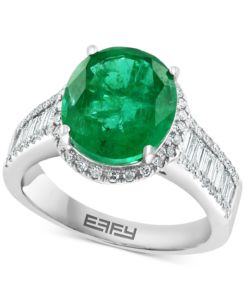No gem is more famous and desired than emerald. Its intense green has no equal rival. It sparks the imagination and soothes the eye and soul. Its fresh color has long symbolized the growth of a new spring and has always been a sparkling attraction when worn on the ring finger. Few gestures are as bold or romantic—and dashing—as proposing with a beautiful emerald ring.
The emerald gets its name from the ancient Greek word for green, ‘smaragdus’. Almost every ruler across different civilizations have prized it. The Egyptian Queen Cleopatra greatly admired the gem’s glittering beauty. In ancient times, people believed that wearing an emerald on the forefinger brought power.
In modern times, an emerald engagement ring became the popular choice in high society. Prince Rainier III of Monaco proposed to Grace Kelly with an emerald ring; so did a young John F. Kennedy to Jacqueline Bouvier. No matter the nationality, an emerald ring speaks the same universal language of love. Let us guide you through the different considerations you should know when picking the perfect ring.
what Is more important: color or clarity?
Emerald is the green variety of the mineral beryl. Its blue rival is the aquamarine. It ranges from green to blue-green in color. The purest greens or bluish-green stones are valued most. However, to classify as emerald, the color needs to be close to a darker tone.
Emerald is not the only green gem. When buying you should take care not to confuse Emeralds with ‘green beryl’. Whilst both Green Beryl and Emeralds are from the same family of gemstones – they are definitely not the same. Green Beryl is much more common, costs less and do not contain as many inclusions when compared to Emeralds. You get also peridot and tourmaline in green. But neither can match the emerald’s alluring color. It recalls lush rolling green landscapes and hints of a freshly mowed golf course. It conveys regality and tranquility. The color depends on its origin. Zambian emeralds have more blue tints. Colombian emeralds are warmer. If the gem does not contain many inclusions, the value increases dramtically. If the color is without eye-visible color zoning (uneven color distribution), it is even more desired.
Clarity can affect its pricing. Clean intense colored stones are almost non-existant. As a result, they fetch high prices. Yet all emeralds contain some levels of inclusions, which have their own beauty. Eye-visible natural inclusions have a mossy appearance known as ‘jardin’, the French term for ‘garden’. Too many inclusions, however, can reduce the gem’s value dramatically.
So when you search for the gem you desire, keep this in mind: it is almost impossible to find completely eye-clean stones. They’re also quite pricey. But the right cutter can polish and shape the rough stone into a sparkling gem for your engagement ring.
How do enhancements affect the price of an emerald ring?
Treatments and enhancements can strengthen this gem’s color and clarity. However, it is not usually heat-treated like rubies and sapphires. Instead, they are oil-treated to improve their appearance and make their beauty long-lasting. As it is a common procedure, any emerald you pick will have been treated in some way, so rest assured.
How do you pick the carat size?
Emeralds can come in a host of different sizes suitable for an engagement ring. Tiny stones from the Sandawana emerald mine in Zimbabwe come as small as 1mm and rarely go above a weight of 1.50 carats. Then there are stones that can weigh as much as 19 carats.
The price is connected to the size. This also depends on quality. The bigger the stone, however, the higher the price. You will have to base your choice on how much you have allocated in your budget. In general, if you are aiming for a single center stone, 1 to 5 carat stones are ideal.
What is the best shape and cut for an emerald ring?
An emerald can be cut and shaped in different ways. The most famous is the emerald cut (rectangular or square with the corners ‘cut’ – in effect, almost octagonal) — the cut gets its name from this gem. Other popular choices are the round, oval and cushion cuts.
Each cut creates a different effect.
The emerald cut has a rectangular shape that draws out the stone’s distinctive green and maximizes its elegant flair. Round cuts pair wonderfully with accent stones. Oval cuts enhance the stone’s size. When worn on a small hand, an emerald or round cut engagement ring can make your partner’s fingers appear longer.
In contrast, the soft square shape of a cushion cut has a vintage aura. It used to be the choice of cut in the past for emerald engagement rings.
Emerald is more brittle than other gems. The proper cut can minimize vulnerability in daily wear. What’s more, the cut can alter its original shade of color—lighter stones can be darkened with a deep cut; a shallow cut can lighten a dark stone.
What metal goes well with emerald?
Any metal can be used to make an emerald engagement ring. Some types work better than the rest. Platinum is contemporary and sleek. Yellow and rose gold metals have a more nostalgic feel and enrich the emerald’s vibrancy. They are hardier too.
Since the emerald is delicate, you should strongly consider investing in a resilient metal for your ring. While silver is less expensive, especially in relation to white gold or platinum – which are similar in color.
One stone or accent stones?
This opens up another question: one stone or accent stones?
The secret to a classy emerald ring is not to diminish its brilliance. Overly complex gem combinations can overwhelm its beauty. Platinum and white gold rings are best with a single gorgeous and minimalist center stone. If you have the budget for it, though, a few accent diamonds can add fire to the classic emerald center stone.
Oftentimes, simple works best!
How to care for your emerald ring?
Emerald is a 7.5 to 8 on the Mohs scale. This means it is fair to good in toughness. Although it requires more looking after than sapphire or ruby, this gem can last for generations with the proper care. While it is ‘hard’ – always remember it is a brittle stone.
When cleaning your emerald ring, use warm soapy water and scrub gently. You also want to avoid exposing the stone to chemicals and heat that can damage it.
If your partner is an active outdoors type or works in an environment that could subject the ring to harsh impacts, it could damage the gem rapidly.
How much does an emerald ring cost?
If your heart is set on an emerald, you should know that their demand is higher than most other colored gemstones. For a gem with a brilliant shine, you have to get a stone weighing at least 5 carats.
On the very high end, you might have to pay over $100,000 for a 3 + carat Colombian ring. A solitaire ring of 4 carats and more can fetch a price tag of nearly $300,000. At the more reasonable level , you might have to be prepared to shell out anywhere from between $1,200 to $5,000.
An emerald ring is for the bold of heart! It’s the reason why the rich and famous woo their beloved with emerald: it is an investment. Yet seeing your partner’s eyes light up when the ring sparkles on their hand makes the price completely worth it.
Even after centuries, this May birthstone continues to kindle flames of desire in the heart. As the emblem of spring, it perfectly symbolizes the start of a new life together with your partner. An emerald birthstone ring is a solemn vow, signaling your devout intention to build a strong beautiful life. At the end of the day, it is not about whether you can afford it: it’s about how much you are willing to spend on your one true love.

